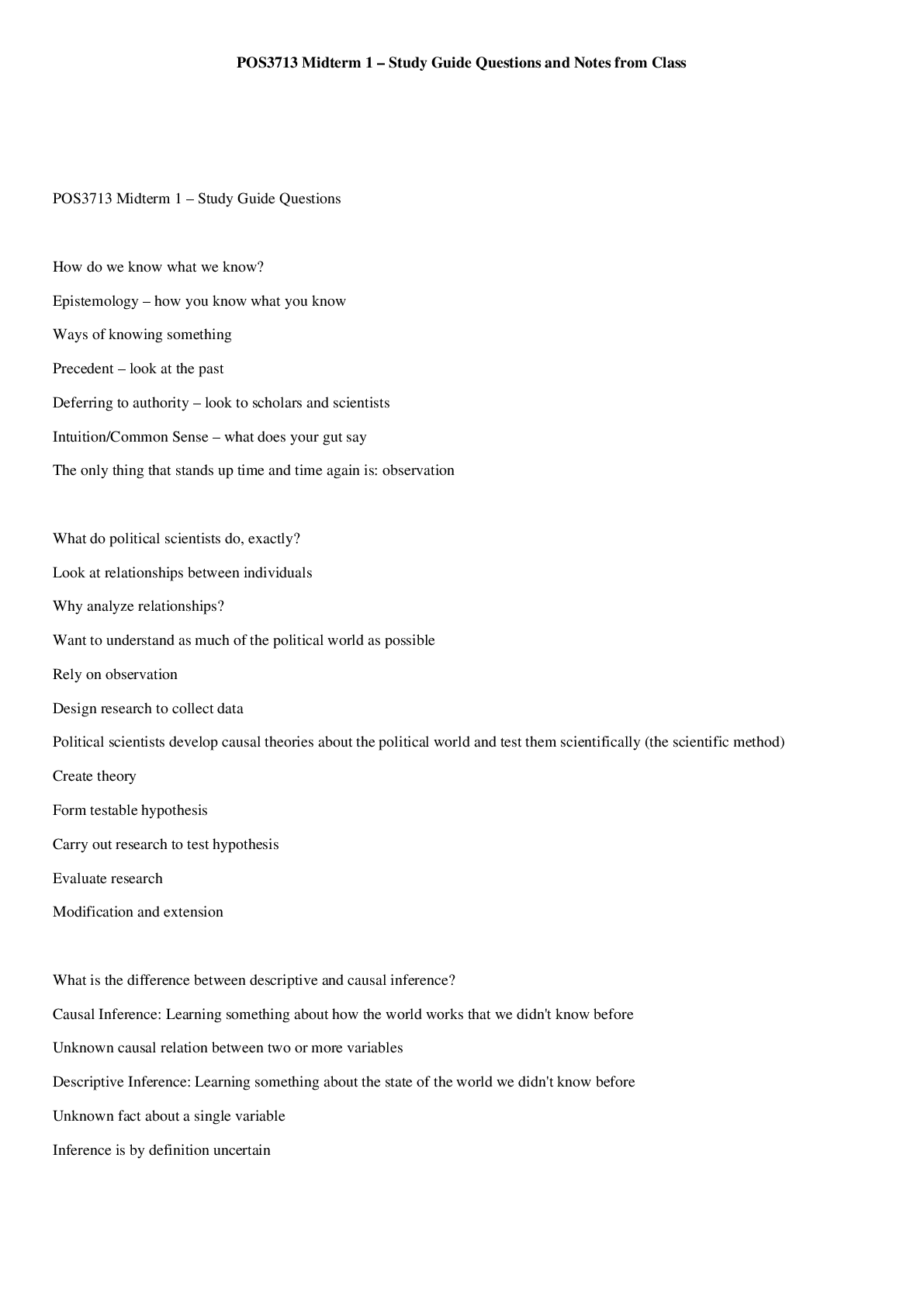NURSING. > STUDY GUIDE > NURS 2111 MB Module 3 Study Guide Questions with Answers,100% CORRECT (All)
NURS 2111 MB Module 3 Study Guide Questions with Answers,100% CORRECT
Document Content and Description Below
NURS 2111 MB Module 3 Study Guide Questions with Answers Mother Baby Class Notes Module 3 Conception- union of the egg and sperm Fertilization – takes place in the outer ⅓ of the fallopian ... tube, called ampulla Implantation- 6 to 10 days after conception Embryo- 15 days to 8 weeks after conception this is what the egg is considered Fetus- 9 weeks up until delivery this is what its considered Viability- the baby’s ability to live without the mom-- the baby is viable at about 24 weeks Amniotic membrane contains chorian outside of the placenta Chorion (outer membrane) develops from trophoblast. Contains chorionic villi and becomes the fetal side of placenta. Amnion develops from interior cell blastocyst. Embryo draws amnion around itself, forming a fluid-filled sac covering the umbilical cord and the chorion on the fetal side of placenta Amniotic fluid- increases weekly, usually about 800-1000 mL of fluid surrounding the baby (once baby is term), the fluid protects the baby from infection, provides support/cushion and warmth, and provides a means of fluid intake, helps maintain babies' temp. Oligohydramnios- 500 ml or less of amniotic fluid, can cause renal abnormalities and inadequate placental blood flow Polyhydramnios or hydramnios- over 2000 mL of amniotic fluid- GI malfunction, digestive malfunctions, or CNS malfunctions. Placenta- thick disc shaped substance, 2 sides of a placenta: the shiny side shiny shoals, is the fetal side, the dirty side is going to the mom the diary of the pregnancy, provides O2, nutrients, meds, virus’ and infections can pass through the placenta Umbilical cord covered with Wharton's Jelly to prevent cord compression. Cord around the neck is called a nuchal cord. Umbilical cord- 2 arteries and 1 vein, vein carries oxygenated blood to fetus from placenta, arteries carry deoxygenated blood and gets rid of all waste products by transporting in the mom’s system. Roughly 20-24 inches long. Grows from fetal end. Is coiled, mostly at the fetal end. Coiling present by 9-10 weeks. Non-coiled cords have risks for stillbirth, preterm labor, IUGR, meconium, oligohydramnios, fetal anomalies, lowered Apgar scores, and higher NICU admissions. Fetal circulation - fetus does not breath in air,so air is shunted from liver and lungs three shunts: • ductus venosus- bypasses the liver and enter the inferior vena cava • ductus arteriosus- blood from the right ventricle join oxygenated blood • aorta foramen ovale- shunts oxygenated blood from the right and left atrium Maternal blood flow- there are two circulating systems-- maternal placenta circulation & fetal placenta circulation. These two systems never mix! Maternal circulation takes all of the waste products and gets rid of it. • Maternal blood flows through the uterine arteries into the intervillous spaces then return through uterine veins to maternal circulation (Utero-Placenta circulation) • Fetal blood flows through the umbilical arteries into the villous capillaries and returns through the umbilical vein to fetal circulation. (Feto-placenta circulation) Developmental tasks of pregnancy: • -Learning about pregnancy (takes childbirth classes about 26 to 28 weeks) - ideal time to take a type of class to learn all of things to be learned and what to expect would be before pregnancy. • -Preparing to care for the infant • -Financial adjustments • -Redefining role • -Adjusting sexual patterns • -Adapting relationships with family/friends Your prenatal attachment - the bond that the mother has with the baby even though she has never seen the baby. The mother/child attachment begins with the diagnosis of pregnancy. It is a very strong affiliation with one another. How parents attach to the child affects the entire life cycle. It may be difficult for a rape victim to become attached to the baby. Circumstances are different for everyone. Perhaps father is not involved. Parents may be disappointed. May be financial issues. Culture - your beliefs, customs, values that are learned and passed down. Acculturalization- a person leaving their own culture and beliefs to join and be with someone that is of a different nationality-- leaving your beliefs and values behind. Examples - • only able to drink hot liquids for a period of time, then cold liquids for a period of time for a yin and yang • Colostrum is bad for the baby so they do not feed the baby right away. • African americans put a penny over the navel • Staying in the house for a certain number of weeks after having a baby. • Leaving umbilical cord attached. Maternal tasks of pregnancy - accepting pregnancy and establishing relationships with the fetus. All of her decisions must include the baby. Separating the fetus from self is when she delivers the baby and see’s baby in the crib. Paternal tasks of pregnancy- accepting pregnancy, establishing a relationship with the fetus, becoming involved with pregnancy, adjusting to changes in self and changing relationships. Mother should take father to appointments, exercise together, same diet, etc.. to help father adjust to pregnancy as well. Adaptation of the family - siblings. Grandparents and other extended members. Incorporate kids- let them feel the baby move, take kids to appointments to find out what the baby is, allow them to help name the baby, etc. For grandparents - they usually make themselves involved. Give them roles and keep them informed with pregnancy. Let them be the babysitter. Physiologic changes in pregnancy: Was the pregnancy unwanted? Adolescent pregnancy could cause school interrupted, early marriage, divorce, unemployment, care of newborn, and prenatal care. Diagnosis of Pregnancy: human chorionic gonadotropin: can be seen 6 to 11 days after conception. • Presumptive signs- signs that are felt by the woman. Amenorrhea, breast changs, fatigue. • Probable signs- felt or seen by the examiner. Hegar's sign (uterus feels softened), Chadwick's sign (bluish color of cervix), . Ballottement (being able to bounce the uterus and feeling it rebound) and pregnancy tests (watch for false positives) diuretics can cause a false negative. • Positive signs are hearing FHR and seeing the fetus on ultrasound and palpating the fetal outline. Nagele’s Rule- used to calculate possible due date-- add 7 days to the first day of the LMP, count backwards 3 months and add 1 year if needed. EX: LMP: June 9th 2014. EDD: 03/16/15 Tips for early pregnancy - • Avoid X-rays, live vaccinations, meds, alcohol, tobacco, and occupational hazards • Seek early prenatal care • Allow for diagnosis and intervention of ectopic pregnancy - outside the uterus • Abortion is safest in first 12 weeks Nutrition in Pregnancy: • Improving one’s diet during pregnancy cannot overcome previous deficiencies. A good diet reduces risks of maternal complications, helps promote tissue growth normally, and increases likelihood that the fetus will get to optimal weight. Need calcium, omega-3 fatty acids, vitamin D (600 IU) and choline (eggs and chicken). • During the first 2 trimesters weight occurs primarily in maternal tissues. • During the 3rd trimester growth occurs primarily in the fetal tissues. • The first trimester the average total weight gain is 1-2.5 kg. Thereafter, recommend 0.4kg per week for a woman of normal weight. Recommend a woman increases her calories 300 calories/day. These calories should be from milk, yogurt, cheese, fruits, vegetables, bread, cereals, rice, and whole-grain pasta. • Obese 11-20 pounds, overweight 15-25 pounds, and underweight 28-40 pounds. Maternal pre-pregnancy weight is a predictor of neonatal body composition. • Obese clients need folate and B vitamins. These women have a BMI >25. They have risks for gestational diabetes, preeclampsia, infection, preterm labor, VTE, cesarean birth, prolonged labor, stillbirth, and PPH. • Eating disorders are associated with abortion, stillbirth, hypertension, cesarean birth, low birth weight, fetal anomalies, low Apgar scores, increased risk for hemorrhage, and birth trauma. Also have a higher risk for postpartum depression. Trimesters: • 1st- 1 to 13 weeks • 2nd- 14 to 27 weeks • 3rd- 28 to 40 weeks Initial Prenatal Visit- first visit: • Health History - consists of demographic data, a detailed health history, present health, menstrual/obstetric history, and present and past pregnancy symptoms and problems. • Psychosocial Assessment - consists of the woman and her partner’s attitudes towards the pregnancy, emotional, and financial impact on the family and the expectations of the woman and those involved. • Physical exam - VS (baseline determined at first visit. BP is lowest early in pregnancy. Is considered abnormal if rises 30/15, ht, wt (pre-pregnant and pregnant). Normal weight gain is 10 lbs. at 20 weeks, gain 25-35 lbs by term, approx 2.2 lbs per visit (if more, assess diet, edema) and a systems’ assessment. • Laboratory tests include a Pap smear, vaginal cultures, urine specimen (protein is not normally present). Assess for edema, check for preeclampsia and kidney disease. Recommended to test for diabetes if not already a diabetic. Ketones indicate burning fat, need to assess diet, blood could indicate UTI or kidney disease). Blood studies (sickle cell, Hgb & Hct, Rh) EDD) also determined. Determine blood group and Rh. Many HCPs do HIV testing, GC, and VDRL or RPR to see if she has syphilis. CDC suggests chlamydia screening for all pregnant women (retest during third trimester). Prenatal Visits- • 1-28 weeks: every 4 weeks • 29- 35 weeks: every 2 weeks • 35 weeks until delivery: every week Fundal height should be equivalent to number of weeks that mother is pregnant Transvaginal ultrasound confirms pregnancy, confirms gestational age and rule out ectopic pregnancy. At 16 weeks discuss triple or quad screen. This is a blood test that measures hCG, estriol and AFP. Used to r/o or screen clients at risk for Down syndrome and open neural tube defects. Maternal21™ or Harmony™ – screening test O’Sullivan test – normal is ≤130 mg. If abnormal, the client has a 3-hour GTT. Give CHO load 3 days before the 3-hour GTT. For an obese, pregnant client the screening occurs at 20 weeks. No fasting required for O’Sullivan. If mom is already diabetic, glucose is checked on first visit to help manage the sugar levels. GBS- bacteria that some people carry on their body in the vaginal/rectal area-- normally done around 36 weeks-- if culture is positive then the mother will have antibiotics during delivery-- it is harmful to the baby because the baby has a decreased immune system Leopold’s Maneuvers- used to determine fetal position and helps the nurse or doctor determine the best place to get heart tones on the baby. 1st assess for breech or cephalic Know the landmarks of pregnancy! • 8 weeks - FHR (fetal heart rate) heard with Doppler • Before 12 weeks - uterus in pelvis • After 12 weeks - uterus in abdomen • 20 weeks - FHR heard at umbilicus • Quickening (movement of fetus felt by mother) @ 16-20 weeks • Ultrasound done prior to 20 weeks is very accurate Systems for charting pregnancies: will be on the test (also called the OB index) • G- gravida -- number of pregnancies • T- term pregnancy • P- preterms pregnancies • A - abortions (spontaneous and elective) • L- live births G2 T1 P0 A0 L1-- has 1 child and pregnant with one Miscarriage is listed under abortion before 20 weeks Assessment of fetal health: • Ultrasound - congenital anomalies/anencephaly, BPD, crown-rump length, head circumference, femur length, abd circumference, microcephaly, multifetal gestations, pelvic masses, placental location, vaginal bleeding, and amniotic fluid volume (AFI). Amniocentesis - done at 16-20 weeks for genetic studies. Done during the 3rd trimester for lung maturity and amnionitis. • Lecithin & Sphingomyelin ratio - 2:1 indicates lung maturity. • Non-stress test (NST)- most common, non-invasive test of fetal well being. Indirectly assesses placental/respiratory function by observation of the FHR in response to fetal movement. The nurse puts the baby on the monitor. Reactive: 2 FHR accels within a 15-20 minute timeframe of 15 BPM for 15 seconds if 32 weeks or greater. If <32 weeks, the 10X10 rule applies. These are called accelerations. Looking for FHR <110 or>160 and decelerations. If you put the baby on monitor and you don't get 2 accelerations, feed mother or give her some juice. Change position of baby (maybe is in sleep cycle. Need 40 minutes of no accelerations before you can call it nonreactive. • Contraction test (OCT). IV started with oxytocin drip. Establish contraction patterns. We want to see 3 contractions within 10 minutes lasting 40-60 seconds. FHR should not decelerate (decrease in heart rate) • BPP (Biophysical profile) - provides a score using 5 parameters (NST, gross body movement, fine body movement, fetal breathing activity, and amniotic fluid volume). Acceptable score is 8-10. If a score of 6, repeat within 24 hours. If a score of 4 or less, plan delivery. • Kick counts - client lies in comfortable position for approximately 30 minutes. May be done BID. Counts how many times the fetus moves within that time frame. Should get at least 4. If not, extend to an hour; should get 10 with the woman’s drinking 8 ounces of water. Want 10 movements in 2 hours. • NIPD (noninvasive prenatal diagnosis)– 10/11 introduced this test to screen for Down syndrome as early as 7 weeks by using a sample of maternal blood. • Nuchal translucency – ACOG recommends. Done at 11-14 weeks. Determines Down syndrome, Trisomy 18, Turners, and heart defects. ASSESSMENT OF FETAL well being for High risk pregnancy: • Percutaneous umbilical blood sampling- commonly called cordocentesis. Fetal blood is collected from the umbilical cord by passing a fetoscope. Done for more advanced testing, genetic karyotyping • Chorionic villus sampling- assessing portion of the developing placenta, aspiration through syringe. Performed at 10-13 weeks gestation. Done for more advanced testing of fetal anomalies…..genetic testing • Maternal serum alpha- fetoprotein (MSAFP)- screening for neural tube defect spine, spinal cord, brain Signs & symptoms to report: Vaginal bleeding, dizziness (possible compression of vena cava-- lay on side), preterm labor symptoms, rupture of membranes (water breaks-- increased risk for infection-- go to hospital), preeclampsia/eclampsia (pre: high blood pressure-- excessive swelling in hands or feet) Eclampsia: (seizures), change in fetal movement. Lifestyle threats to pregnancy: • Smoking can contribute to low birth weight, IUGR (intrauterine growth restrictions) and preterm labor. Also, SAB (spontaneous abortion), bleeding, abruptio placentae and placenta previa. In the fetus can increase the chance of SIDS. • Alcohol and drug abuse can cause fetal alcohol syndrome - fetal blood level > maternal, drug withdrawal (irritability, agitation, hypertonicity, feeding disorders, diarrhea, dehydration. Sudden withdrawal can cause fetal death, addiction and is a risk factor for poor compliance to prenatal care. Clients who use amphetamines are more likely to have preterm births, an SGA newborn, or low birth weight newborn. • Family violence can make a woman feel helpless, depressed, or trapped. Abusive men often abuse children also. The women are also in danger if they threaten to leave and end the relationship. Domestic violence increases 60% during pregnancy. • Obesity is a threat because of spontaneous AB, gestational HTN, gestational diabetes, postpartum hemorrhage, and sleep apnea. • Women who use NSAIDs may have a higher risk for “miscarriage”. • social skills, and autistic traits in neonate. Promoting a Healthy Pregnancy: Exercise, no contact sports or scuba diving, environmental safety (no live vaccines-- only PPD & FLU), wear seatbelt & protection from the sun), dental care (risk for preterm birth.) Physiologic changes in pregnancy: • CARD: slight hypertrophy due to the increasing blood volume and cardiac output. There is a split of the S1 and S2 heart sounds, and an S3 murmur about 50% of time. Between 14 and 20 weeks the pulse increases about 10 to 20 BPM. Palpitations may occur. Cardiac rhythm may be disturbed. There is hypertrophy of the left ventricle. The heart shifts position in 3 ways (upward, closer to anterior wall, and PMI towards axillary area). BP varies with age. During 1st trimester BP usually remains at the prepregnancy level. During the second trimester both SBP and DBP decrease. This is due to the peripheral vasodilation caused by hormones. Blood volume increases 40 -50%. This takes place in order to give blood flow to the placenta and fetus. Increased cardiac output (6-8 liters/minute). Decreased SVR. • RESP -The diaphragm displaced upward by the enlarging uterus. However, the increased levels of estrogen cause the ligaments of the rib cage to relax, permitting the chest to expand. The upper airway is more vascular because of the increase of estrogen and may lead to nosebleeds. This increase in vascularity may also affect the eustachian tubes as well as the tympanic membranes and give rise to Sx of impaired hearing, fullness in the ears, or even earaches. The pregnant woman breathes deeper, but her respiratory rate will be slightly elevated (10 breaths more). Normal blood gas values: pH 7.40-7.45; PaO2 104-108; PaCO2 27-32; HCO3 18-21 (She is in compensated respiratory alkalosis.) • RENAL: increased GFR. Ureters dilate and elongate. Frequent urination initially results from increased bladder sensitivity and later the compression of the bladder. Fluid retention may occur. Body may store 6-8 liters. Side-lying position with elevated feet helps this. Decreased level of bladder tone under the influence of estrogen. • INTEGUMENTARY: changes from hormones (linea nigra and striae gravidarum). May be due to adrenocorticosteroids. May be genetic. Dark near term; will never go away but will fade to silvery color. • MUSCULOSKELETAL changes – waddle; large, distended abdomen gives pelvis a forward tilt, and some relaxation of pelvic joints. During the 3rd trimester rectus abdominis muscles begin to separate in preparation for labor and birth. • GI - may be a fluctuation in appetite. Early pregnancy some have nausea with/without vomiting. This is due to increasing levels of hCG or altered carbohydrate metabolism. Endocrine changes are necessary for normal fetal growth and the maintenance of pregnancy. Their sources are hormones . • REPRODUCTIVE SYSTEM i- greatly changed. Uterus: at 7 weeks is size of hen egg; at 10 weeks size of orange;;12 weeks grapefruit; during 2nd trimester rises out of the pelvis; and the pregnancy may begin to show around week 14. Uterine measurement and growth are determined by fundal height. Usually equal to gestational age. Uterus may contract by 4th month (Braxton Hicks contractions). Cervix will soften. Leukorrhea may occur; increased vascularity may cause bluish discoloration. Breasts begin to enlarge; areola may enlarge; breasts may become tender. • Most pregnant women are in constant stress Nulliparous- never been pregnant, never given birth Primigravida- 1st time giving birth Multigravida- given birth two or more times Gestational Hypertension- before 20 weeks and resolves before 12 weeks postpartum S/S: • Absence of protein in the urine, • sudden weight gain, • increased BP greater than 140/90, they can turn into chronic HTN that is long term.Increased blood pressure • Absence of protein in the urine (to diagnose gestational hypertension • Edema (swelling) • Sudden weight gain • Nausea, vomiting • Urinating small amounts Nursing interventions: • Encourage the patient to rest as much as possible in the lateral recumbent position to improve uteroplacental blood flow and reduce her blood pressure. • Monitor blood pressure daily. Weigh herself for any weight gain. Encourage patients to drink 6-8 glasses of water daily • Administer antihypertensives as ordered, monitor for effect • Encourage a low sodium diet. • Monitor fetal heart rate • Weigh the patient daily, monitor for EFV • Monitor daily labs, monitor for hypernatremia • Monitor patient for edema Patient Education: • A temporary diagnosis but it can become chronic HTN. • Occurs after 20 weeks gestation and resolves by 12 weeks postpartum • Diagnosed when systolic is > 140 and/or diastolic is >90 at least twice when taken at least 6 hours apart after 20 weeks gestation • Provide diet and lifestyle education Misc info: • Reduce salt intake to less than 6 gms / day (approx 1 tsp/day). Table salt should not be used. Avoid pickles, papads, biscuits, bakery items and preserved foods like sauce, chocolates, processed cheese, chips mixture etc. Pre eclampsia/eclampsia: S/S: • Goal is to decrease blood pressure and increase perfusion • severe headaches. • vision problems, such as blurring or seeing flashing lights. • severe heartburn. • pain just below the ribs. RUQ pn (liver is not perfusing like it should-- spilling protein because of intracellular involvement) • nausea or vomiting. • excessive weight gain caused by fluid retention. • feeling very unwell. • sudden increase in edema – swelling of the feet, ankles, face and hand (periorbital edema) • Patient does not respond with bedrest • At risk for placental insufficiency- baby not getting needed oxygen or nutrients • Place baby at risk for IUGR • Premature birth or delivery • Death Eclampsia- includes seizures and coma Preeclampsia: • 300 mg or more of protein in the urine seen with a 24 hour urine collection-- spillage of protein due to intracellular involvement • Increased creatinine levels • Appears without a warning • Develops after 20 or more weeks • HTN & Proteinuria • Blood pressure range: 160/110 • Platelet levels decreased • Uric acid elevated • BUN elevated • AST & ALT elevated Nursing interventions: • Regular diet- no salt or fluid restrictions • Consistent BP readings • Daily weight checks • Bed rest • Labetalol • Hydralazine (po or IM) • Mag sulfate - patient will be in the hospital-- used to reduce BP & prevent seizures by causing the body to relax • Mag is given to decrease the seizure threshold! • Mag excreted out of kidneys • Assessment- urine output, DTR’s to make sure they are not getting too much mag. • Lung sounds. • Mag Bolus loading dose given: 4 to 6 gram dose over 30 minutes & 2-3 grams per hour for maintenance dose. Therapeutic range is 6 to 8. • Mag Toxicity: • Decreased DTR”s • Decreased urine output • Decreased Respirations • Decreased or diminished LOC • Hypotension • Must assess every hour: • Lung sounds • DTR’s • Urine output Antidote for mag: calcium gluconate Nursing interventions: • Risk of seizures • Seizure precautions: • Pad rails • Bite block • Suction at bedside The only cure for preeclampsia is delivery of the fetus and placenta. Medication can lower blood pressure and thus reduce the risk of stroke in the mother, but these treatments do not improve the underlying abnormalities in the placenta and thus does not prevent progression of the disease. The management of pregnancies complicated by preeclampsia depends on the gestational age and whether severe features of the disease are present. The method of delivery (vaginal or cesarean birth) depends upon a number of factors, such as the position of the fetus, the dilation and effacement (thinning) of the cervix, and the fetus's condition. In most situations, vaginal delivery is possible. Oxytocin (Pitocin) is given intravenously to induce labor (stimulate the uterus to contract). If labor does not progress, or if complications develop that require the fetus to be delivered quickly, a cesarean birth may be indicated Use betamethasone to mature baby’s lungs- given in 2 doses 24 hours apart Misc Information: • Avoid diuretics • Monitor for edema • Daily weight should be recorded • Evaluate Deep tendon reflexes especially if the patient is receiving magnesium HELLP -Hemolysis Elevated liver Enzymes, Low Platelet count S/S: • Progression of Preeclampsia • Hemolysis (breaking down red blood cells), Elevated Liver Enzymes (causing liver damage), Low Platelet count (as low as 20,000) • Headache • Nausea/Vomiting • Abdominal or chest tenderness and upper right side pain (from liver distention)-- epigastric pain • Shoulder pain or pain when breathing deeply • Bleeding! • Bruising • Changes in vision • Swelling • Fatigue • Extreme weight gain Nursing Interventions: • - Bed rest and admission into a medical facility to be monitored closely. • -Corticosteroid- betamethasone (to help babies lungs develop more rapidly) • -Magnesium Sulfate (tto help prevent seizures) • -Blood transfusion if platelet count gets too low. • -High BP • -Protein in urine Pt education: • Risk of fetal morbidity and mortality for future • Trust yourself when something “just doesn’t feel right” • Know your warning signs and report them immediately • Have regular prenatal visits Misc information: • Complicates 10% of pregnancies with severe preeclampsia • -Life threatening • -May require critical care admission • -Requires immediate delivery Hemorrhagic Complications -(Type of Abortion) (Please include types): S/S: • Incomplete abortion, which may need to be followed by surgical abortion • An ongoing unwanted pregnancy if the procedure doesn't work • Heavy and prolonged bleeding • Infection • Fever • Digestive system discomfort Types: • Spontaneous: 1st trimester usually. Severe anomalies and chromosomal abnormalities are major causes. Maternal infections, endocrine disorders, reproductive defects. After abortion pain stops, bleeding resolves. • Threatened: slight bleeding lasting several days or weeks. May include uterine cramping, pelvic pressure, pain, no cervical dilation. • Inevitable: can not be stopped, ruptured membranes, cervical dilation, active bleeding, natural expulsion vs, DC if excessive bleeding • Incomplete: some of the products of conception remain in the uterus and cause bleeding and pain, cervix opening (curettage, 0xytocin, cytotec, methergine -- causes uterus to clamp down and go back to pre-pregnancy state) • Complete: all POC expelled, instruct to watch for bleeding and infection (in a lot of pain) • Missed: fetus dies but is retained, Intrauterine fetal demise (IUFD) - give patient cytotec, oxytocin or D&C depending on gestational age. • S/s of pregnancy disappear, uterus stops growing, may abort spontaneously, if not D/C, 2nd trimester prostaglandins to induce, infection and DIC complications • Recurrent: genetic, reproductive abnormality, inadequate luteal secretion, progesterone-antigen response, lupus, diabetes, infection. Nursing Interventions: • The nurse must be familiar with post abortion complications and the risk to the woman. • Assess maternal physiological circulatory status and blood volume. • Monitor nature, severity, location, and duration of pain. Assess for uterine contractions, retroplacental hemorrhage, or abdominal tenderness. • Assess client’s/couple’s psychological stress and emotional response to the event. • -Provide support to clients, physical and emotional. If the client needs it (emotional). Pt education: • Medical abortion isn't an option if you: Are too far along in your pregnancy. You shouldn't attempt a medical abortion if you've been pregnant for more than nine weeks (after the start of your last period). Some types of medical abortion aren't done after seven weeks of pregnancy. • Have an intrauterine device (IUD). • Have a suspected pregnancy outside of the uterus (ectopic pregnancy). • Have certain medical conditions. These include bleeding disorders; certain heart or blood vessel diseases; severe liver, kidney or lung disease; or an uncontrolled seizure disorder. • Take a blood thinner or certain steroid medications. • Can't make follow-up visits to your doctor or don't have access to emergency care. • Have an allergy to the medications used. Ectopic Pregnancy: S/S: • Pregnancy occurs outside of the uterus-- implanting in the fallopian tubes. • Abnormal implantation. • Goal is to preserve fallopian tubes. • Abdominal pain, amenorrhea, and vaginal bleeding. Symptoms of early pregnancy including breast tenderness, nausea, fatigue, shoulder pain, and low back pain. Hallmark sign is abdominal pain with spotting within 6 to 8 weeks after a missed menstrual period. • Usually diagnosed by transvaginal ultrasound. • Low HCG levels-- sign that something is not quite right. • Levels checked every 3 days. • Methotrexate is the medication of choice which stops the rapid growth of the fetus. • Medication is given on an outpatient basis. • Given in 3 doses, if not resolved in 3 doses we have to do surgery to remove the tube that contains the pregnancy. Nursing Interventions: • Administer analgesics as ordered to promote comfort and relieve discomfort from abdominal pain • If the woman is treated medically, explain the medication that will be used and what she can expect. Also review signs and symptoms of possible adverse effects. If surgery is needed, close assessment and monitoring of the client’s vital signs, bleeding (peritoneal or vaginal), and pain status are critical to identify hypovolemic shock, which may occur with tubal rupture. If treatment will occur on an outpatient basis, outline the signs and symptoms of ectopic rupture (severe, sharp, stabbing, unilateral abdominal pain; vertigo/fainting; hypotension; and increased pulse) and advise the woman to seek medical help immediately if they occur. Pt Education: • Prevention education is essential because the avoidance of conditions that cause scarring in the fallopian tubes can decrease the chances of developing an ectopic pregnancy. Prevention education may include the following: • -Reduce risk factors such as sexual intercourse with multiple partners or intercourse without a condom. • -Avoid contracting STIs that lead to PID. • -Obtain early diagnosis and adequate treatment of STIs. • -If an intrauterine contraceptive system is chosen, descriptions of the signs of PID should be included to reduce the risk of repeat ascending infections, which can be responsible for tubal scarring. • -Avoid smoking during childbearing years since a correlation and increase in risk exists. • -Use condoms to decrease the risk of infections that cause tubal scarring. • -Seek prenatal care early to confirm the location of pregnancy Misc Information: • -The use of transvaginal ultrasound to visualize the misplaced pregnancy and low levels of serum beta-hCG assist in diagnosing an ectopic pregnancy. • -If rupture or hemorrhage occurs before treatment begins, symptoms may worsen and include severe, sharp, and sudden pain in the lower abdomen as the tube tears open and the embryo is expelled into the pelvic cavity; feelings of faintness; referred pain to the shoulder area, indicating bleeding into the abdomen, caused by phrenic nerve irritation; hypotension; marked abdominal tenderness with distention; and hypovolemic shock. • -The woman with an ectopic pregnancy requires support throughout diagnosis, treatment, and aftercare. Provide emotional support, spiritual care, and information about community support groups as the client grieves for the loss of her unborn child and comes to terms with the medical complications of the situation. Hydatidiform Mole (Molar pregnancy): S/S: • A noncancerous tumor that develops in the uterus as a result of a nonviable pregnancy. The womb develops but there is no fetus inside. Grape-like vesicle clusters. • Irregular vaginal bleeding. Rapid growth of the womb causing pelvic pressure. Pallor due to bleeding. Sudden abdominal pain in the first trimester. N/V. signs and symptoms of hyperthyroidism such as tremors, restlessness, high BP in the first trimester due to high level of HCG. no viable fetus present • Large uterus, excessive N/V because of extremely high HCG levels, anemia, HTN, & Increased pelvic pressure. Nursing Interventions: • • Assess the Bp check if bleeding profusely. • Check for abdominal pain and asses for internal bleeding. • If a client vomits make sure the patient does not aspirate. • Make sure the client has good perineal hygiene to prevent infection. • Provide emotional support. • Monitor hcg levels during follow up. • Treatment: o Suction D & C o Serial HCG levels- can be done for up to 1 year-- advise patients not to get pregnant due to increased risk of another molar pregnancy. Pt education: • after surgery While your bleeding continues, it is best to use sanitary pads instead of tampons, as this will reduce the risk of infection. Baths or showers can be taken as required. • Breasts may be tender for several days and you may even leak milk. In this case wear a well fitting bra, day and night, to provide adequate support until your breasts are comfortable. • If you have had molar pregnancy, consider talking with doctor because they may recommend to wait at least 6 months to a year before trying to get pregnant again Misc information: • Two types: complete and partial. • Complete has an empty ovum, partial has partially formed normal villi with a macreated embryo present. • Labs including, blood test to monitor hcg levels, and a thyroid function test is done, ultrasound chest X ray or Lung CT or performed to diagnose. Placenta Previa: S/S: • Is a condition in which the placenta blocks the cervix. • Bright red vaginal bleeding that is painless in the 2nd half of pregnancy. • Bleeding can be associated with uterine contractions & abdominal pain. • Other sn/sx: • Premature contractions. • Baby in breech (buttocks or feet closest to the cervix) or transverse position (horizontally across the uterus, rather than vertically.. • Uterus measures larger than it should according to gestational age. Nursing Interventions: • assist the woman in the side lying position when bleeding occurs • sounds so the mother would be aware of the health of her baby. • Allow the mother to vent out her • feelings to lessen her emotional stress. • Assess any bleeding or spotting that might occur to give adequate measures. • Answer the mother’s questions honestly to establish a trusting environment. • Include the mother in the planning of the care plan for both the mother and the baby. • Measure drainage output • Give steroid in case of early deliver Pt education: • Avoid all strenuous activity, such as running or lifting. • Don’t have sex or put anything in your vagina. • Call your doctor and go to the ER immediately if you have any vaginal bleeding. • If you are close to your due date, baby will be delivered. • You may be given a blood transfusion • Steroids given if you aren’t close to your due date, which helps speed up the baby's lung development. • Tocolytic meds given to slow or stop contractions. o Common meds are: ▪ Magnesium ▪ Indomethacin ▪ Nifedipine • No vaginal exams Misc information: • Three types: o Complete: cervical opening is completely covered. o Partial: a portion of the cervix is covered by the placenta. o Marginal: extends just to the edge of the cervix. • Causes: o Over 35 years o Had more than 4 pregnancies o History of uterine surgery Abruptio Placentae: S/S: • A problem in which the placenta separates too early from the wall of the uterus. • Vaginal bleeding • Abdominal/ low back pain- persistent, rigid and board-like abdomen • Uterine tenderness • High uterine resting tone • Port wine-colored amniotic fluid • Non-reassuring fetal heart rate pattern • Contractions • Decreased fetal movements • Painful Nursing Interventions: • Assess bleeding, pain, VS, fetus, uterine activity, OB Hx. Maintain fluid volume, observe for shock, maintain fetal and maternal tissue perfusion, monitor oxygen and pulse oximeter • Causes are usually from some sort of trauma (fight, fall, drug use, car accident Pt education: • Encourage women to avoid drinking, smoking, or using drugs during pregnancy • Urge to seek early and continuous prenatal care and to receive prompt health care if any S/SP occur in future pregnancies. • Call 911 immediately if you have: Sudden or severe pain in your belly. Severe vaginal bleeding such as a gush of blood or passing a clot. • Sx of shock: o Light-headed o Feeling of fainting o Confusion o Restless o Weak o Nausea o Vomiting o Fast, shallow breathing. • In most cases of moderate to severe abruptio placentae, the baby will have to be delivered quickly, which will most likely involve having a c-section. MIsc information: • Classified according to the extent of separation and amount of blood loss from maternal circulation. o Mild (grade 1): Minimal bleeding (less than 500 ml) marginal separation 10% to 20 %) o Moderate (grade 2 ) : Moderate bleeding (1,000 to 1500 ML) moderate separation ( 20% to 50%) o Severe (grade 3) : absent to moderate bleeding (more than 1,500 ML) severe separation (more than 50%) o Concealed- no visible bleeding occurring outside of the body • Risk factors o Smoking o Cocaine use during pregnancy o Maternal age over 35 o - HTN • Labs- CBC, blood type and screen, cross match, kleihauer betke (fetal and maternal blood mixture) -- might have to give rhogam to the RH- neg Electmoms, • Coagulation studies, drug screen • Test done to diagnose: o Fetal heart rate monitoring to assess baby’s condition and check for uterine contractions. o Ultrasound- can detect about half of placental abruptions. o A blood test for anemia- you can become anemic from heavy blood loss. • Treatment depends on: o How severe the abruption is. o How it is affecting the baby. o How close your due date is. Hyperemesis Gravidarium: S/S: • Severe excessive vomiting, dehydration, loss of appetite, extreme weight loss, weakness, lethargy, wasting if prolonged without treatment, low blood sugars, possible hypotension due to dehydration, dental care due to excessive vomiting, fetal implications • Electrolyte imbalances • TPN • PICC Line Nursing Interventions: • Glucose checks, try to eat small meals, if longer than 3-4 days seek medical intervention, V/S’s, daily weights, rinse mouth after vomiting, fetus checks at OB’s office • Nursing management for the client with hyperemesis gravidarum focuses on promoting comfort by controlling the client’s nausea and vomiting and promoting adequate nutrition. • During the initial period, expect to withhold all oral food and fluids, maintaining NPO status to allow the gastrointestinal tract to rest. • Women with hyperemesis gravidarum commonly are fatigued physically and emotionally. Many are exhausted, frustrated, and anxious. Offer reassurance that all interventions are directed toward promoting positive pregnancy outcomes for both the woman and her fetus. Providing information about the expected plan of care may help to alleviate the client’s anxiety. Listen to her concerns and feelings, answering all questions honestly. Educate the woman and her family about the condition and its treatment options Pt education: • Inform the client/patient to eat snacks frequently and have multiple small meals. (eg. six small meals a day-- high fat & high protein). • Consuming a bland diet may be ideal. • The client/patient should drink cold, clear, and carbonated or sour fluids (eg. ginger ale, lemonade) drink these in small amounts between meals. • The client/patient should eliminate food triggers like spicy foods and high fat foods. • The healthcare provider can recommend the client brush teeth after eating food to prevent symptoms. • The Healthcare provider can inform the client to avoid lying down immediately after eating and avoid quickly changing positions. • Antiemetic such as metoclopramide (Reglan), ondansetron (Zofran), and Corticosteroids (Solu-cortef) can all be administered. • Lastly, the healthcare provider can recommend CAM treatments such as Acupuncture and Acupressure to help alleviate the symptoms of nausea and vomiting caused by pregnancy. Misc Information: • There is no way to avoid this, it’s a body’s response to the pregnancy, and may need medical intervention such as central line, TPN, antiemetics, if the problem persists, for nutrition for the mother and the fetus. • Risk factors: previous pregnancy complicated by hyperemesis, molar pregnancies, history of helicobacter pylori infection, multiple gestation, prepregnancy history of genitourinary disorders, clinical hyperthyroid disorders and prepregnancy psychiatric diagnosis • Smelling fresh lemon, mint, or orange or using an oil diffuser with these scents may be useful. Gestational Diabetes: S/S: • Usually there are no symptoms, a blood sugar test during pregnancy is used to diagnose it. Though some may experience excessive hunger and thirst, fatigue, frequent urination and yeast infections. • • These pts are being tested at 24 -28 weeks with the Sullivan test. • Insulin sensitivity the 1st half of pregnancy • Insulin resistance the 2nd half of pregnancy • Most can control with diet alone. • There is an increased chance of developing diabetes after pregnancy. • Increase prenatal visits. • Fetal wellbeing visits - NST and BPP make sure baby is ok Nursing Interventions: • The foundations. Nutrition, meal planning, and weight control are the foundations of diabetes management. • Consult a professional. A registered dietitian who understands diabetes management has the major responsibility for designing and teaching this aspect of the therapeutic plan. • Healthcare team should have the knowledge. Nurses and other health care members of the team must be knowledgeable about nutritional therapy and supportive of patients who need to implement nutritional and lifestyle changes. • Weight loss. This is the key treatment for obese patients with type 2 diabetes. • How much weight to lose? A weight loss of as small as 5% to 10% of the total body weight may significantly improve blood glucose levels. • Other options for diabetes management. Diet education, behavioral therapy, group support, and ongoing nutritional counselling should be encouraged. Pt education: • Most women are able to control their blood sugar with modifying their diet alone. • You will need to follow the diet guidelines until your baby is born • After your baby is born, you will be able to resume a normal diet Misc Information: • May be at an increased risk of developing type 2 diabetes later in life. • Risk factors include obesity, prior history in pregnancy, glycosuria, and family history of diabetes. Preterm Labor (Cervical Insufficiency) - S/S: • Vaginal pressure, bleeding, nonspecific abdominal pain/lower back pain, vaginal discharge • Incompetent cervix- you have to go through pregnancy to discover that cervix is incompetent • Cerclage- surgical procedure that ties the cervix closed so pregnancy can be prolonged and prevent the cervix from opening • Presents with regular contractions (1 every 10 minutes) • Possible ROM • Positive FFN (protein that the body releases) if the sac releases from the uterine wall, the FFN is released-- swab vaginal area to test this • Fetal well-being test • NST & BPP • Ultrasound to determine if cervix is shortening (normal cervix is 3 to 4 cm long) • Tx: o Mag sulfate- to stop contractions o Procardia- to relax smooth muscles o Betamethasone Nursing Interventions: • provide client/family education, prepare for premature labor if mucus plug has ruptured, prepare for cervical cerclage (if necessary)-- a cervical stitch to help with cervical weakness, address emotional or psychosocial needs • History of preterm labor: • Cerclage • 17 P injections (progesterone injections) that prevents preterm labor-- given IM by home health nurse • No sex • Bed rest • Watch baby for signs of tachycardia which can indicate possible infection especially if water broke Pt education: • Recognize signs and symptoms of preterm labor; Recognize contractions by palpation; Avoid avoid traveling long distances,bed rest; pelvic rest; mild/moderate exercise daily, smoking cessation program (if necessary);avoidance of heavy lifting; progesterone supplementation ; educate pt on risk factors for this condition such as being pregnant with more than 1 baby, having torn cervix from earlier pregnancy, having miscarriages past the 4th month PROM/PPROM: S/S: • PROM: Premature rupture of membranes. • -PROM is the rupture of a bag of water before the onset of true labor. • -Women with PROM present with leakage of fluid, vaginal discharge, vaginal bleeding and pelvic pressure but they are not having contractions. • PPROM: Preterm premature rupture of membranes. • -Defined as rupture of membranes prior to the onset of labor in a woman who is less than 37 weeks gestation • -sudden gush of fluid from the vagina • - leaking of fluid from vagina • -feeling of wetness in underwear Nursing interventions: • - Assess for signs of infection • - Maternal and fetal infection may prompt PROM and must be treated quickly to avoid fetal compromise. • - Perform single digital or sterile speculum vaginal exam • - Vaginal exam may be required to confirm diagnosis, but avoid multiple digital vaginal exams to reduce the risk of infection. Reserve these exams for when delivery is imminent. • - Obtain history from patient regarding complications and status of pregnancy. • - Treatment depends on gestational age and existing complications • - Patient may need to remain on bed rest to continue pregnancy if preterm, or labor may be induced. • - Initiate fetal monitoring • - PROM may be an indicator of fetal distress. Monitor for signs of fetal compromise to include changes in fetal heart rate. • - Administer medications and IV fluids as appropriate • Prophylactic antibiotics • Corticosteroids • Tocolytics • Magnesium sulfate • - PPROM may indicate a need for corticosteroids to speed up the fetal lung maturity • - Antibiotics are given prophylactically to prevent infection • Tocolytics may be given to stop preterm labor • - Magnesium sulfate may be given if prior to 32 wks gestation to prevent fetal neurological dysfunction • - Prepare patient for induction of labor and delivery • - If indicated, labor will likely be induced if it does not spontaneously begin within 12-24 hours. Explain the process to the patient to reduce fears. • - Provide patient education if preterm • Pelvic rest • Avoid tampons and intercourse • Avoid tub baths (showers ok) • - If delivery is not indicated(<34 wks gestation), the patient will likely remain in the hospital until delivery is an option. • - Regardless of location, patients will be required to remain on bed rest and antibiotics will continue prophylactically until delivery. Pt education: • Hospital stay and bed rest: • Watch for signs of contraction. • Your baby movement and heart rate • Symptoms of infection-fever and pain • May need corticosteroids education. Corticosteroids help the babies lungs grow. If the baby is born early, the lung may be underdeveloped. • Antibiotic education- risk for infection • Tocolytic education. Medicines used to stop preterm labor. • Stop smoking • Call doctor as soon as you see sign and symptoms • Cause is usually unknown • Increase chances of having baby early • Teaching for women with PPROM: • Monitor your baby’s activity by performing fetal kick counts daily. • Check your temperature daily and report any temperature increases to your health care provider. • Watch for signs related to the beginning of labor. Report any tightening of the abdomen or contractions. • Avoid any touching or manipulating of your breasts, which could stimulate labor. • Do not insert anything into your vagina or vaginal area—no tampons, avoid vaginal intercourse • Do not swim in pools or in the ocean or sit in a hot tub or Jacuzzi. • Take showers for daily hygiene needs; avoid sitting in a tub bath. • Maintain any specific activity restrictions as recommended. • Wash your hands thoroughly after using the bathroom and make sure to wipe from front to back each time. • Keep your perineal area clean and dry. • Take your antibiotics as directed if your healthcare provider has prescribed them. • Call your healthcare provider with changes in your condition, including fever, uterine tenderness, feeling like your heart is racing, and foul-smelling vaginal discharge. MIsc information: • High risk factors associated with preterm PROM: low socioeconomic status, multiple gestation, low BMI, tobacco use, history of preterm labor, placenta previa, abruptio placentae, UTI, vaginal bleeding at any time during pregnancy, cerclage, and amniocentesis. • The exact cause of PROM is not known but may be associated with vaginal bleeding, placental abruption, microbial invasion of the amniotic cavity and defective placentation. • To diagnose PROM or PPROM, several procedures may be used: the nitrazine test, fern test, or ultrasound. Anemia: • Normal physiologic changes cause increases in blood volume and RBC production during 2nd and 3rd trimesters which results in a decrease in Hgb and Hct. • Normal blood gas values in pregnancy: pH 7.40-7.45; PaO2 104-108; PaCO2 27-32; HCO3 18-21 • List foods high in iron • Symptoms may not develop until Hgb 6-7. True labor VS. False Labor- • Regular contractions vs. irregular contractions • Increasing vs. inconsistent • Back contractions vs. abdominal • Intensifies with walking vs. relieved • Bloody show vs. none • ROM vs. no ROM Twins: • Identical come from the same ovum. Are always same sex. • Fraternal comes from 2 ova. Risks include LBW, congenital anomalies, IUFD, competition for nutrition, 2 separate cords can get tangled, causing cord compression. May be premature due to increased contents in the uterus. • “The more twins share the worse they do!” • Identical twins – one ovum divides. Same sex, same genotype. 2 amnions, 2 chorions, and 2 placentas or 2 amnions, 1 chorion, and 1 placenta. • Fraternal twins – 2 ova. 2 amnions and 2 placentas. Increased in African American population, fertility issue management, and multiparity. • Rates have risen. • Plasma volume increase of 50-100% • Ultrasound is done in first trimester and serially each month • Client may be delivered at 37 weeks • Median gestational age: triplets 32.1 weeks, twins 35.5 weeks, single 39 weeks. At all gestational weeks multi-fetal births complicated with IUGR have poor outcomes. Infections in Pregnancy: • Sepsis/Chorioamnionitis - Sources are staph, strep, and beta groups. At risk for ROM, STI and kidney disease. Culture for chorio may not show what is found in amniotic fluid culture. • Hepatitis B: 75% have no S/S. If so may be skin rash, low-grade fever or hepatosplenomegaly. Perinatal transmission is cause of concern. Women should be immunized, if at risk (spread by fecal/oral, sexual, body fluid routes). No treatment, neonates born to + mothers should be immunized at birth. Usually all babies are. • TB - untreated causes lung tissue destruction. Can cause other organ destruction. + PPD indicates need for chest X-ray. If positive, IZD for 12 months. Treatment is started during pregnancy. • TORCHS - stands for toxoplasmosis, other (gonorrhea, hepatitis B, varicella-zoster, parvovirus B-19, and HIV), rubella, cytomegalovirus, herpes simplex virus, and syphilis. • Parvovirus B-19-fifth disease “slapped cheek rash” mild skin rash • CMV is most common in TORCHS. Transmitted via secretions and breast milk. Part of the herpes, chickenpox, cold sore family • Toxoplasmosis comes from cat feces. Causes IUGR, hydrocephalus, mental retardation and cerebral calcifications. • If mom has a titer of 1:4 for syphilis, the fetus has a titer of 1:16! • If mom has active HSV lesions, the neonate needs evaluation STI’s in pregnancy: • Chlamydia is the most common form of STI. Most women are asymptomatic. Some S/S are mucopurulent, vaginal discharge, postcoital bleeding, diffuse abdominal pain. Diagnosis is made by cervical culture. Antibiotics for 10 days or one-time dose. Erythromycin and azithromycin. Causes PROM, PTL and LBW. Can cause conjunctivitis pneumonitis in neonate. • Gonorrhea is diagnosed by culture of urethra, cervix, or rectum. Most are asymptomatic; may be similar to chlamydia. Treatment is Rocephin® injection IM X 1 and 10 days of antibiotics. All newborns are given prophylactic erythromycin ophthalmic drops. • Syphilis is screened prenatally and during the 3rd trimester with VDRL or +RPR. Treatment is PCN-G. If infected during pregnancy with treatment < 18 weeks, no problem with fetus. If treated >18 weeks may cause stillbirth and increase spontaneous AB by 25%. • HIV perinatal transmission of HIV to fetus is 40% if treated with AZT >14 weeks goes to 18%. Breast milk can pass the virus. Do not breastfeed. Diagnosis prior to 15 months is difficult because of maternal antibodies. May give a false positive. Neonate receives antiviral. Repeat HIV testing in the 3rd trimester before 36 weeks. [Show More]
Last updated: 2 years ago
Preview 1 out of 25 pages
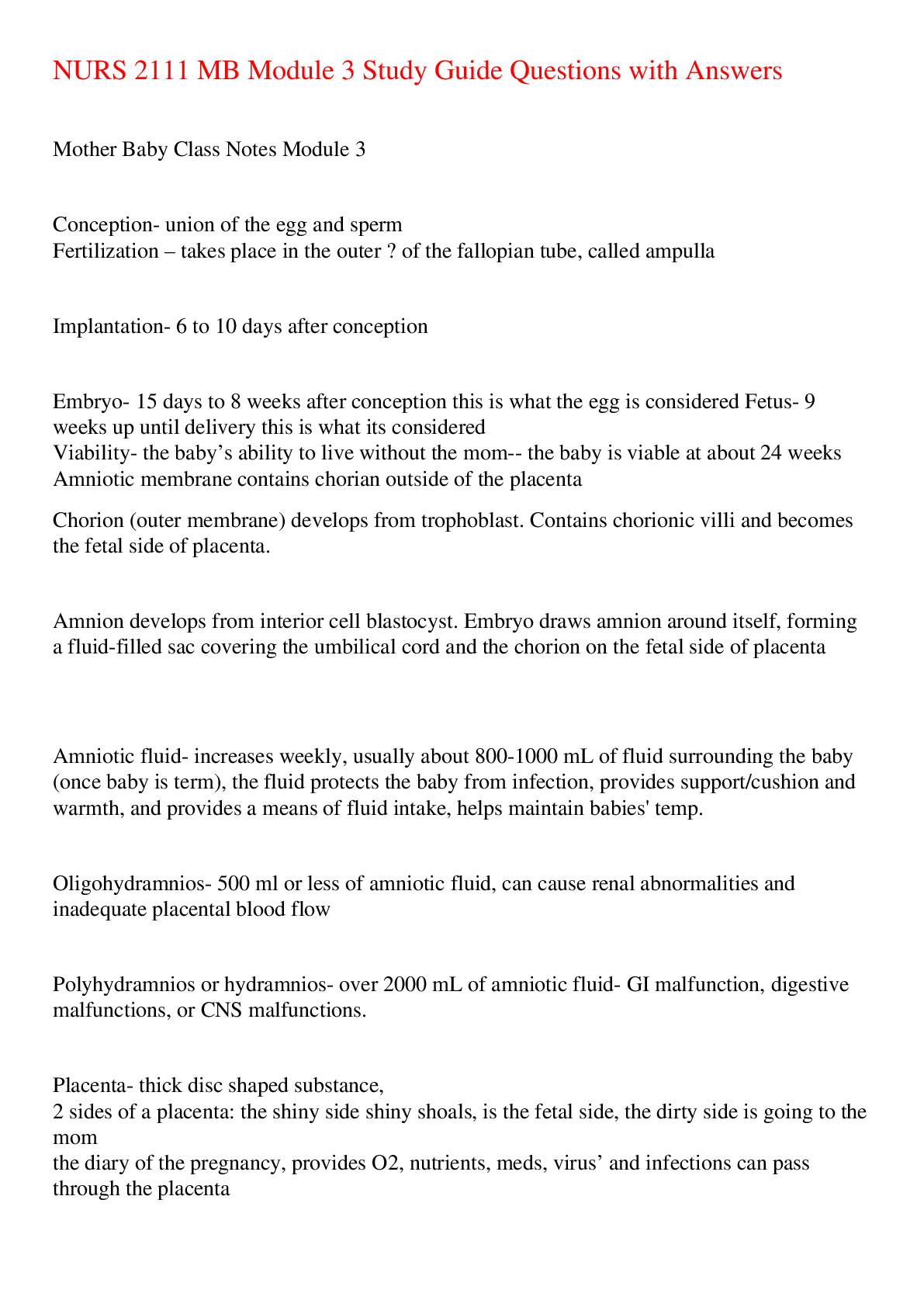
Buy this document to get the full access instantly
Instant Download Access after purchase
Buy NowInstant download
We Accept:

Reviews( 0 )
$14.00
Can't find what you want? Try our AI powered Search
Document information
Connected school, study & course
About the document
Uploaded On
Jun 15, 2023
Number of pages
25
Written in
Additional information
This document has been written for:
Uploaded
Jun 15, 2023
Downloads
0
Views
93

.png)






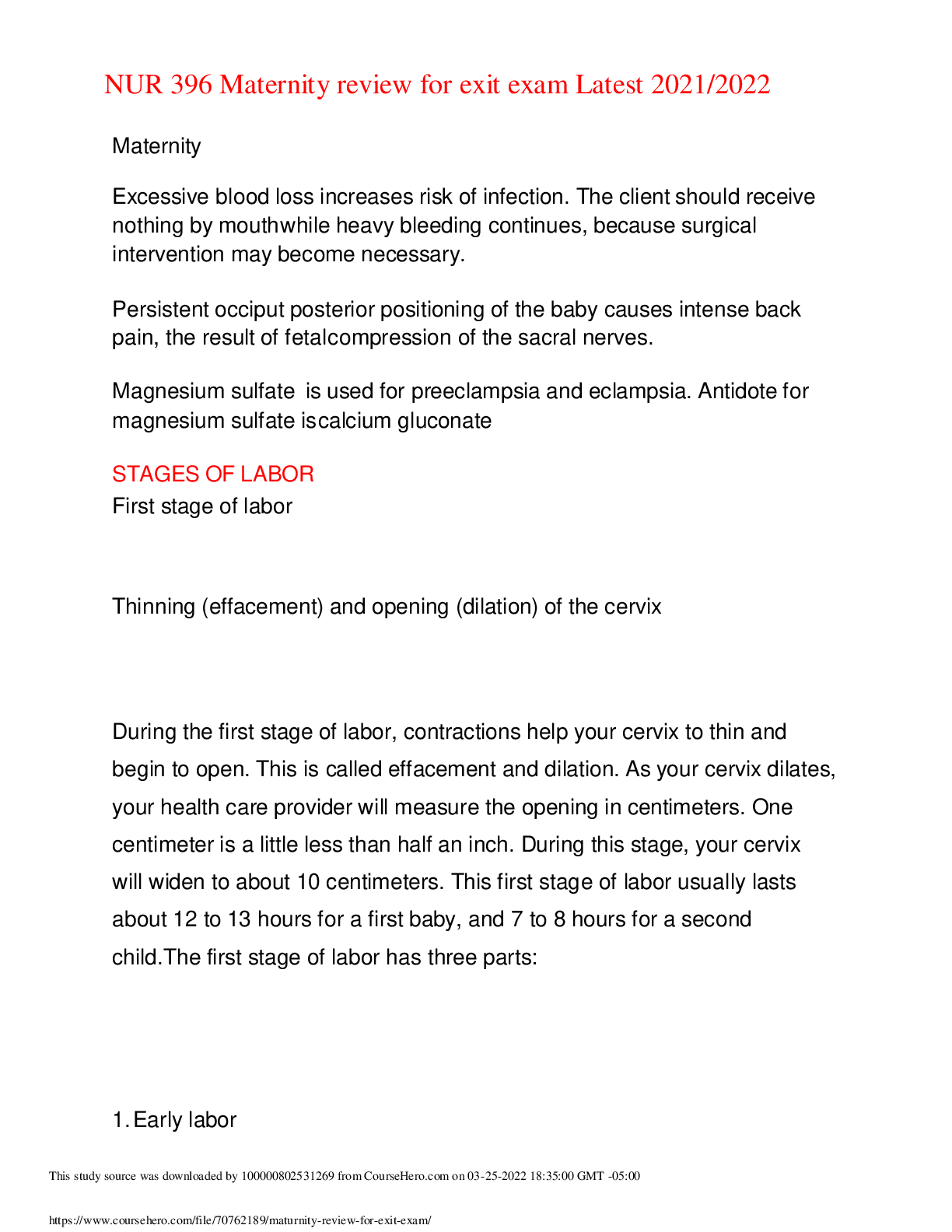

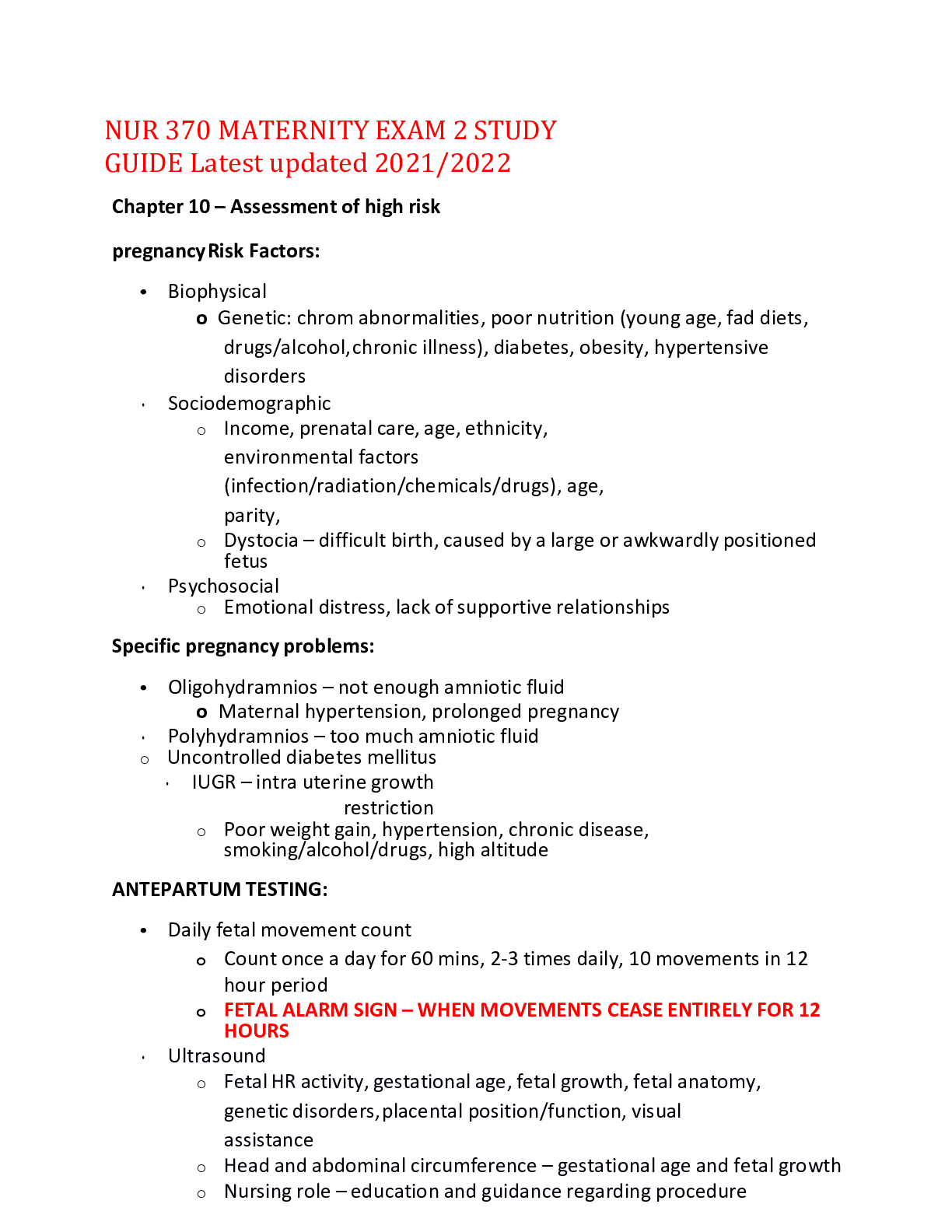


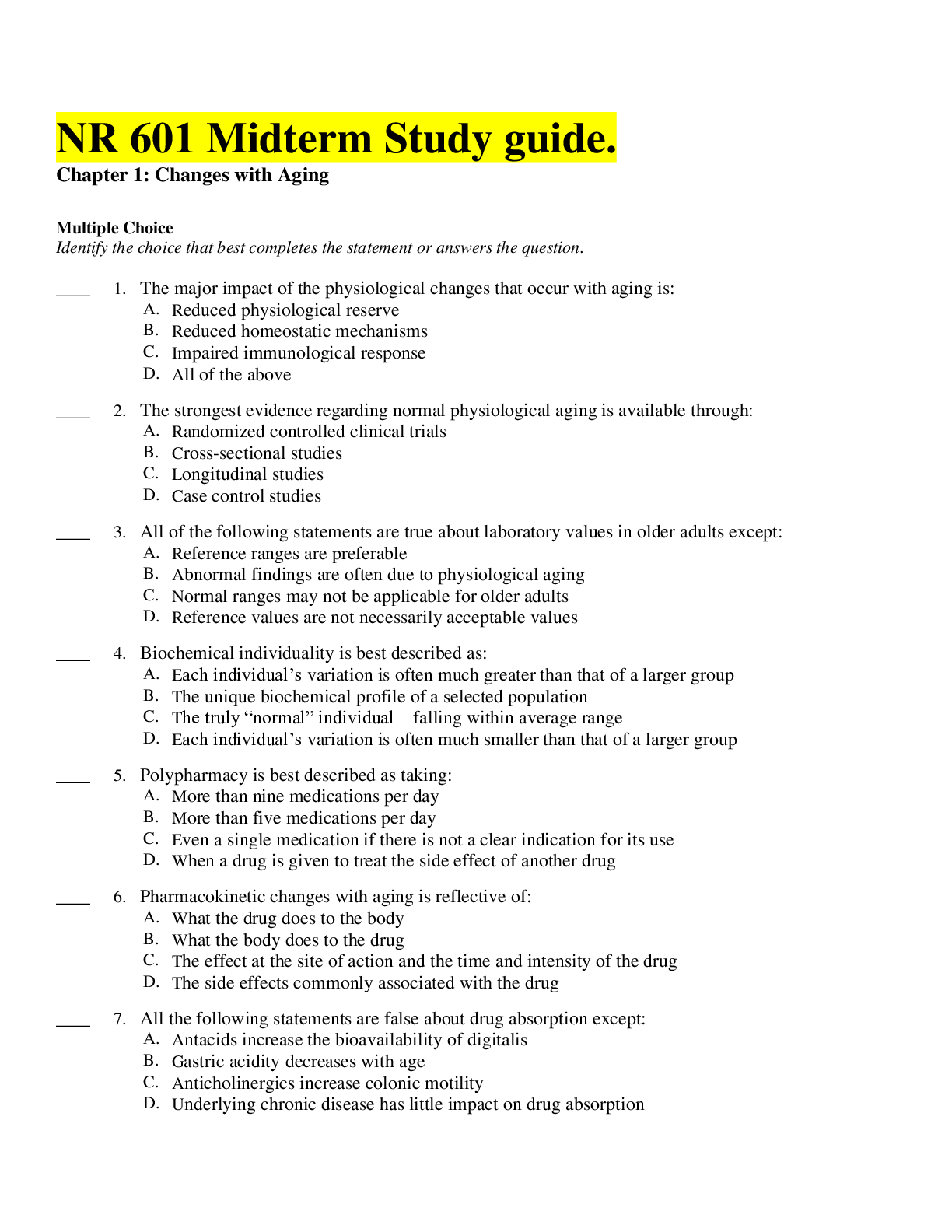
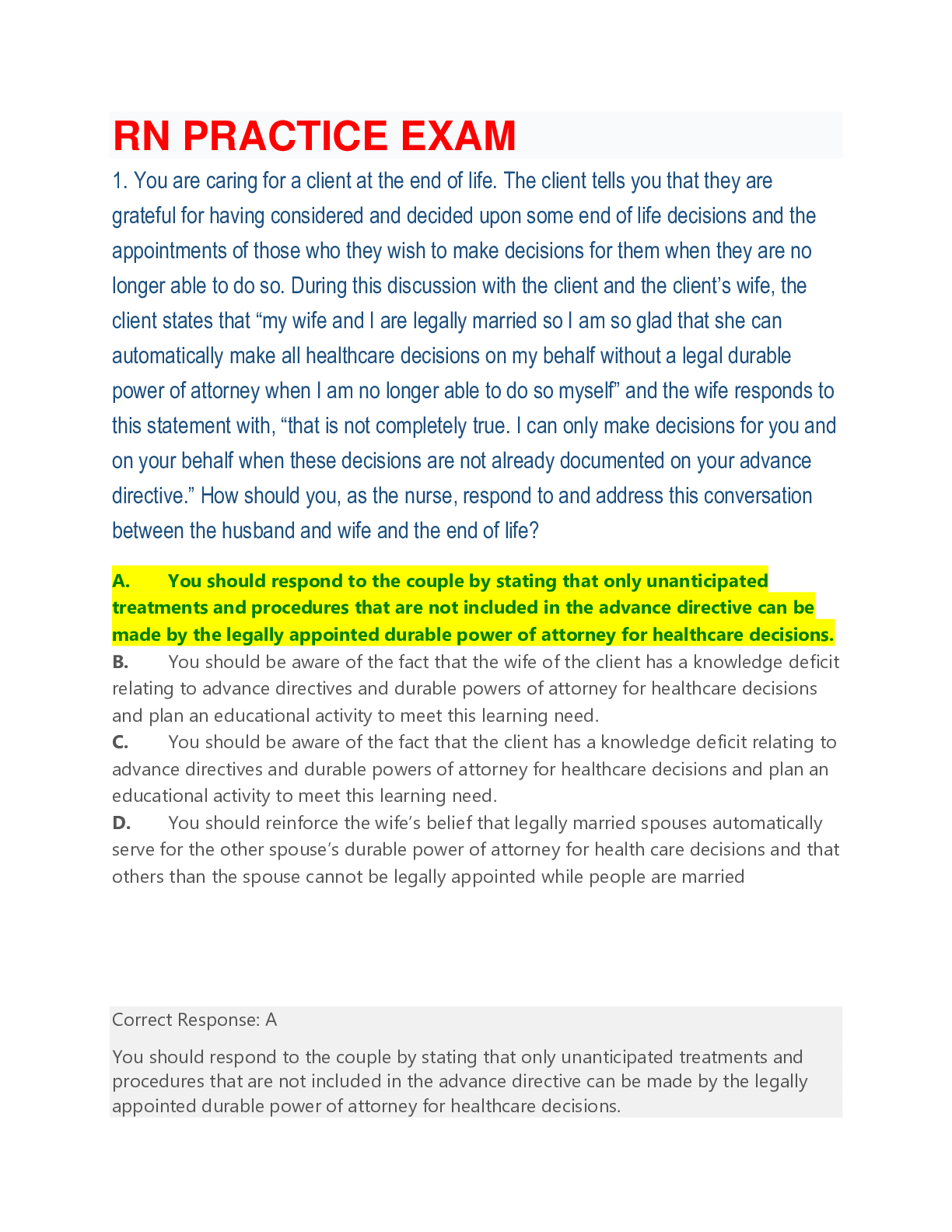


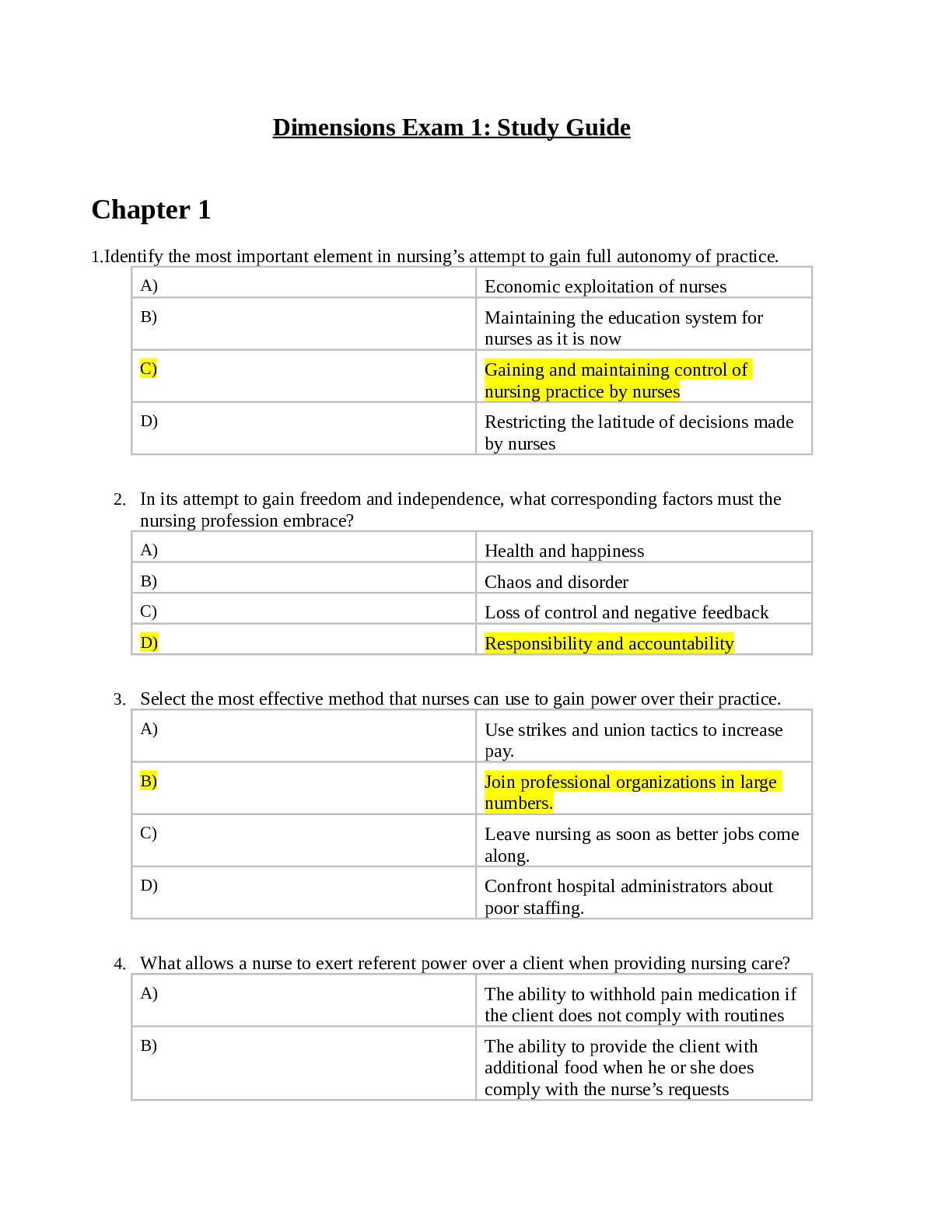


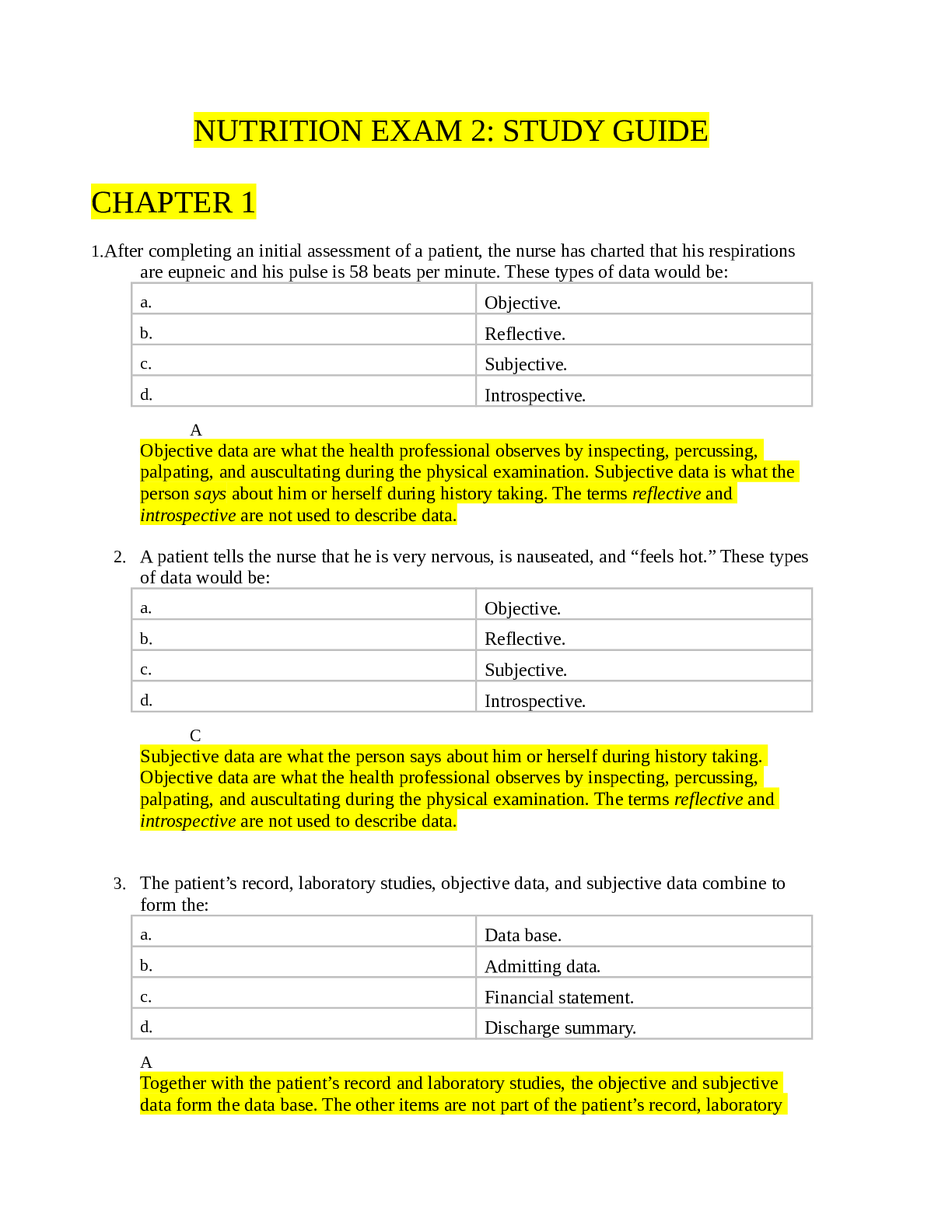
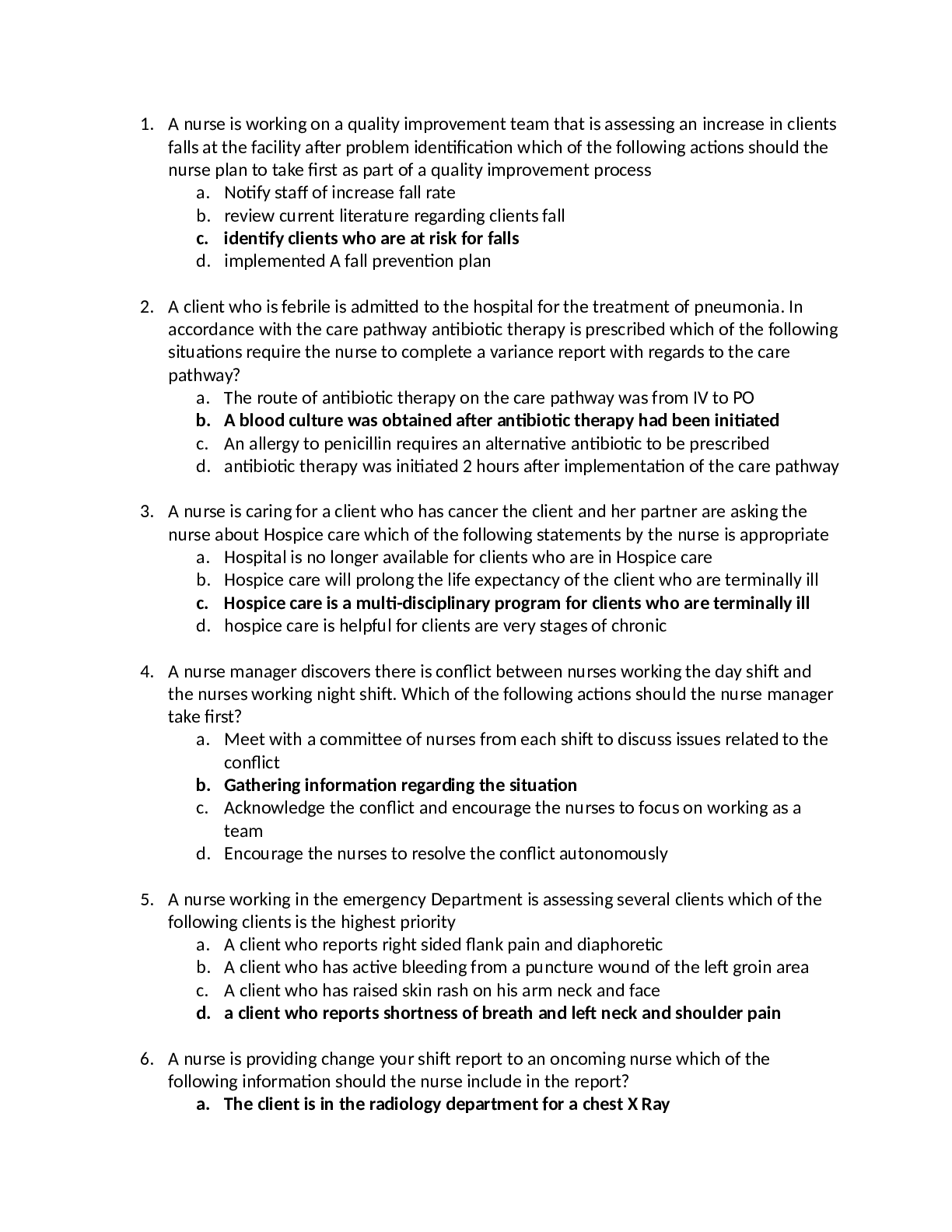
 Primary Care of the Maturing and Aged Family Practicum Midterm Study Guide.png)
